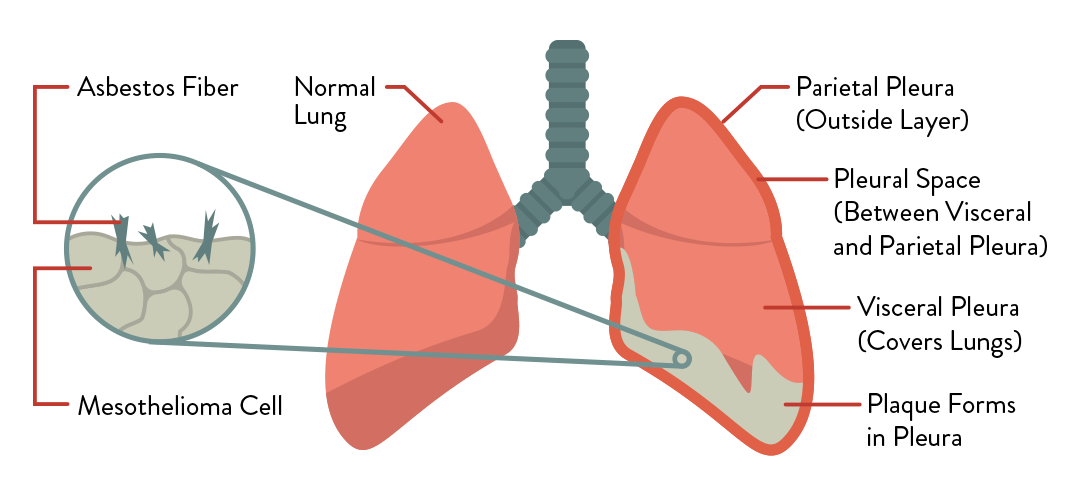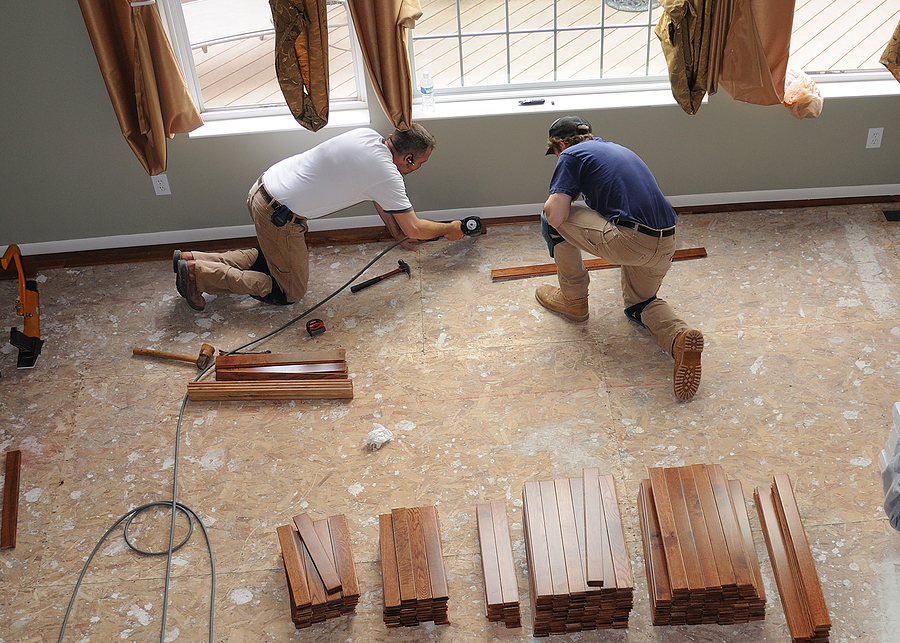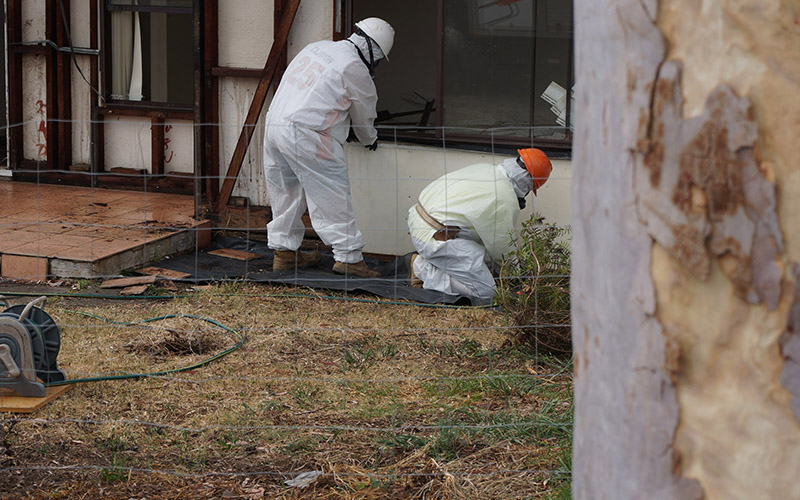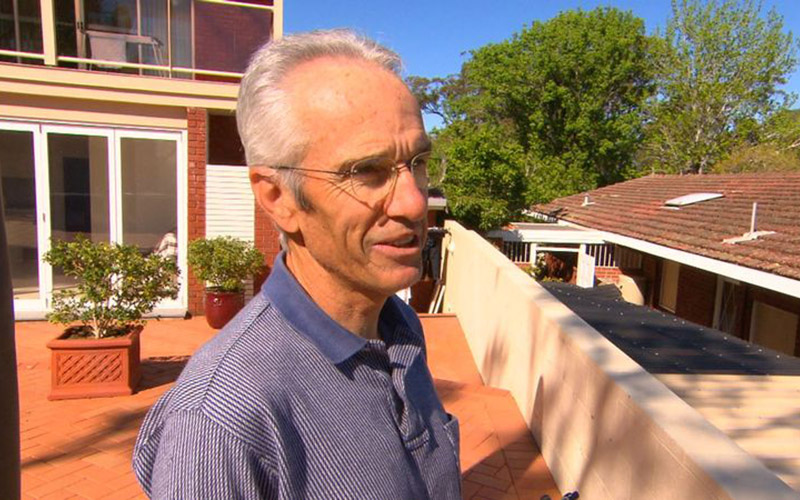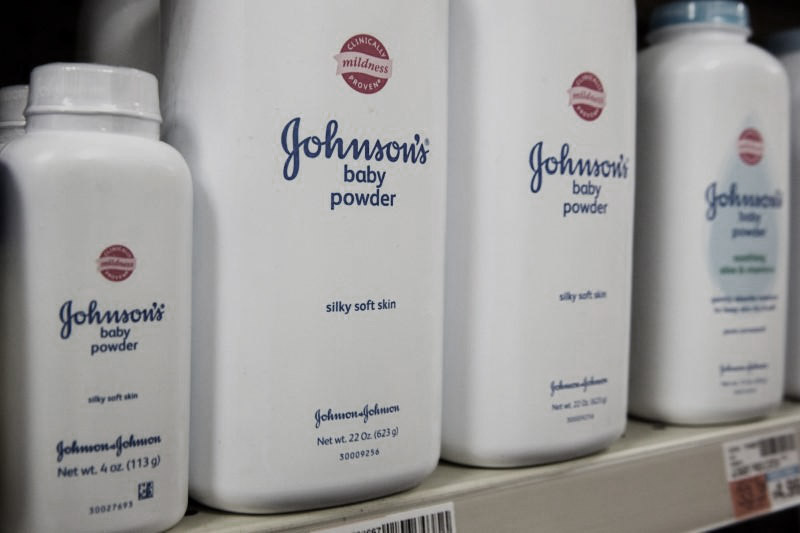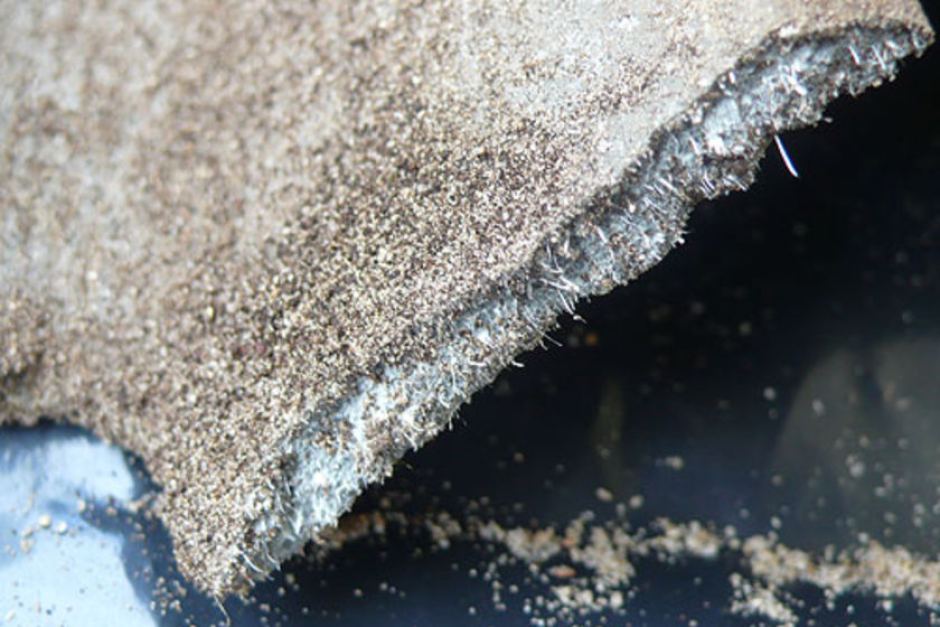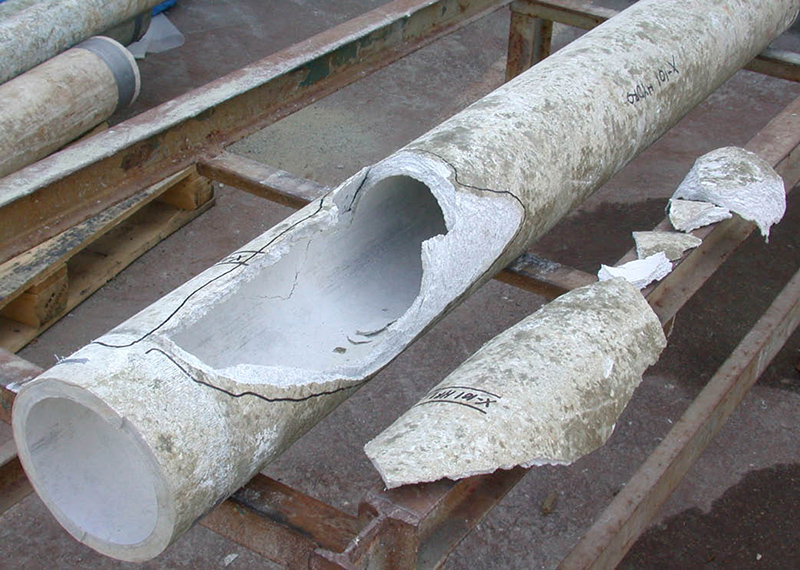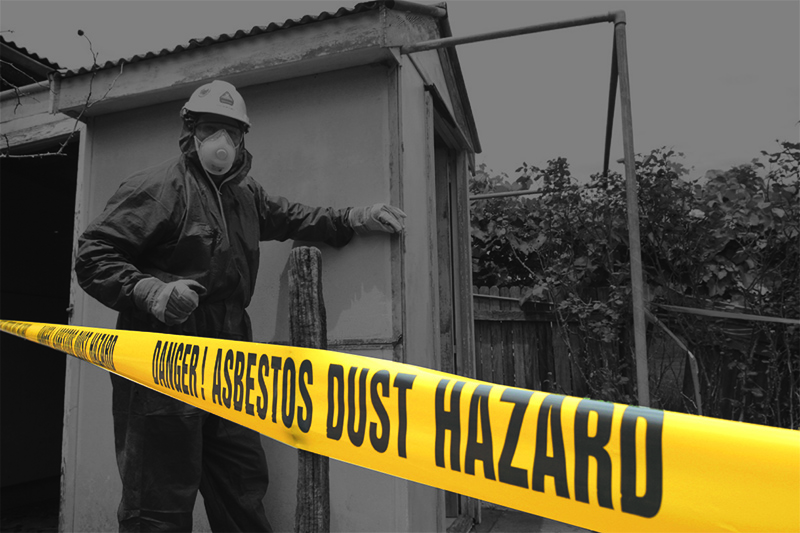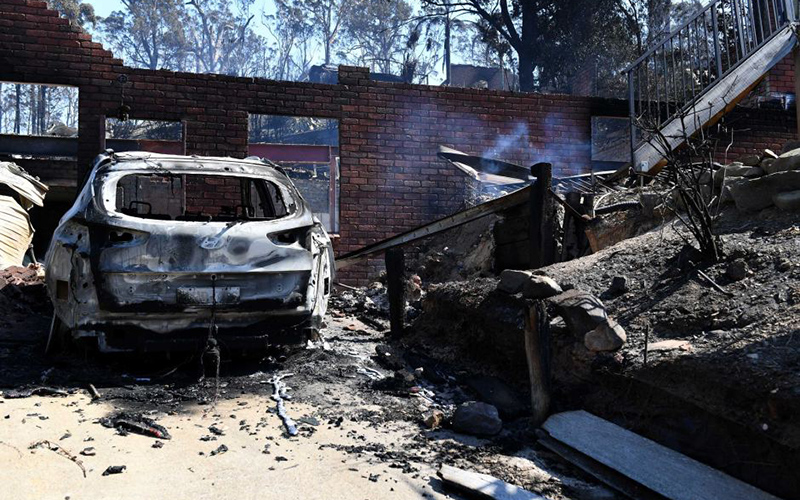Popcorn ceilings were once a popular choice for home interiors but have since fallen out of fashion due to their outdated appearance and potential health hazards. Removing them can be a daunting task, but with the right tools and techniques, it can be done safely and effectively. Follow this step-by-step guide to transform your home into a modern and safer living space.
Read moreThe Ins and Outs of Black Mastic: Everything You Need to Know
If you're planning to use black mastic for tiling or flooring, it's important to take safety measures. Asbestos might be present in it, which can be dangerous if you inhale it. Make sure to follow proper safety guidelines and precautions
Read moreAsbestos And Mesothelioma
The link between asbestos and mesothelioma was first reported in a study of German asbestos workers conducted in 1943. Although this study found a link between lung scarring caused by asbestos fibres - known as asbestosis - and cancer in the mesothelial cells of the lungs and chest, it wasn't until the 1960's that the link between asbestos and mesothelioma began to become widely recognised by the medical community.
Asbestos: It may look harmless, but if inhaled or ingested it can lead to serious health problems.
It took even longer for the general population and industry to take notice of the results, with asbestos being widely used in the Australian housing industry up until 1990. A total asbestos ban was put in place in Australia in 2003 but in many parts of the world, such as Russia, it is still legal to use and even mine asbestos.
Mesothelioma is a type of cancer that affects the body's mesothelial cells (the cells that cover most of the body's internal organs) and is caused by exposure to asbestos. This exposure could occur from inhalation or ingestion; usually by undertaking renovations, through contaminated talcum powder or through work.
There are three types of Mesothelioma, all of which are fatal, and can take anywhere between 10-50 years to develop.
Pleural Mesothelioma is the most common, accounting for 80-90% of all mesothelioma cases. It occurs when asbestos damages the pleural lining that surrounds the lungs and chest. As it is a respiratory condition symptoms include chest pain, shortness of breath, fluid in the lungs (known as pleural effusion) and a dry cough.
Peritoneal Mesothelioma is the second most common type of mesothelioma and each year just under 500 people are diagnosed with this condition globally. This type of mesothelioma occurs when asbestos damages the peritoneum - the thin membrane surrounding the abdomen. Individuals diagnosed with peritoneal mesothelioma usually have a higher rate of survival than those with one of the other two kinds.
Pericardial Mesothelioma, like the name implies, effects the lining surrounding the heart cavity. Because it is extremely rare, the prognosis for patients with this type of mesothelioma is usually around six months.
Home renovators should be cautious of asbestos.
Even though asbestos has been banned here for close to 15 years, Australia still has one of the highest rates of Mesothelioma in the world. In Australia 759 cases were diagnosed in 2014, and a further 675 cases were diagnosed in 2015.
This high rate of mesothelioma is primarily due to the high amount of asbestos in our existing housing supply and our nation's love of home renovations. If you suspect your house might contain asbestos, don't try and remove it yourself, do the safe thing and call in an accredited assessor or a licensed asbestos removal contractor.
Related Articles
Removing Friable Asbestos From Your Home
Until usage was curbed in the 1980's, Australia had one of the highest rates of asbestos usage per person in the world. In 2003 a total ban was placed on asbestos in Australia, making it illegal to mine, manufacture, export or import the deadly substance.
However, this ban couldn't account for all the asbestos already in the housing supply and previously we have talked extensively about the amount and dangers of this legacy asbestos hiding in Australia's homes.
This asbestos is usually found in two forms: Friable and non-friable.
The good news is that if you live in Sydney your house is likely to contain non-friable asbestos, which is the least dangerous of the two as the asbestos fibres are contained in a bonding agent, like cement. Although friable asbestos has been found in some Sydney homes, it saw more widespread use in colder parts of the country like Canberra.
Although certainly less hazardous, non-friable asbestos should still be treated with caution as any damage can break the seal and release dangerous asbestos fibres into the air.
In NSW it is legal for home owners to remove up to 10m2 of friable asbestos themselves; however, this is not recommended and is even illegal in other states, like Victoria.
Friable asbestos removal is always a task best undertaken by licensed professionals as it is a tedious and delicate process. During removal each panel of friable asbestos must be removed individually and intact while being sprayed with water to ensure no asbestos minerals become airborne.
Once the asbestos containing material has been removed it must be wrapped in plastic ad placed in a skip for proper disposal.
Overall, removing friable asbestos is safe and can even be relatively low risk if undertaken properly. However, given the margin for error, it can also be very unsafe if undertaken without thought, planning and the proper safety considerations.
Related Articles
Renovators Beware: The Dangers Of Legacy Asbestos
Up until the mid 1980's, products containing asbestos were commonly used in construction here in Australia. By the late 80's, use began to slow as asbestos-containing products were phased out in favour of asbestos free products. In 2003 a total asbestos ban was introduced, preventing the mining, manufacture, export, import or sale of asbestos products in Australia.
The 2003 asbestos ban was fairly comprehensive; however, it couldn't remove the large amount of asbestos already in Australia's housing supply. Today, homeowners who own a property built or renovated before 1990 should be aware that there is a high chance of their home containing asbestos in one form or another.
Although friable asbestos - the most common type of asbestos found in Sydney homes is relatively harmless if intact, renovation activities can cause damage and release deadly asbestos fibres into the air as a result. Renovation activities like sanding, grinding, drilling, water blasting or cutting can all cause this.
In the past Australian's diagnosed with malignant mesothelioma - a diseased caused by inhaling airborne asbestos fibres, - were those that were exposed through their work, but this is shifting and a growing body of evidence shows that renovators are at high risk of asbestos related diseases such as mesothelioma. A 2014 report released by the Australia Mesothelioma Registry supports this, revealing that of the 350 people diagnosed with mesothelioma during that year, 37.2% of those diagnosed were home renovators.
Diagram of lungs affected by Mesothelioma.
Overall Australia has one of the highest rates of Mesothelioma in the developed world. Although there is no straight forward answer as to 'why' this is the case, the explanation could lie in the large amount of asbestos in our housing supply, the Aussie 'can do' attitude and a general disregard for the risks associated with asbestos exposure.
In order to combat this, if you are considering renovating your home get educated and consider getting a licensed asbestos inspector or occupational hygienist to identify and remove any products containing asbestos that could be in your home.
If you want to find out more about renovating a dwelling containing asbestos National Asbestos Awareness Month has a great selection of free resources you can check out.
Related Articles
Here's What You Need To Know About Non-Friable Asbestos
During its time as a ‘miracle mineral’ asbestos saw wide use in Australia, particularly in the construction industry. Coveted for its durability and resistance to heat, asbestos fibres were used in everything from fibre cement sheeting (often referred to as fibro) to insulation and even as a paint additive.
Corrugated asbestos cement sheeting and asbestos cement sheeting: two examples of non-friable asbestos.
Although a total asbestos ban was implemented in Australia in 2003, there is still a high volume of asbestos in the existing housing supply, specifically in houses built or renovated before 1991. Today as a result asbestos removal and disposal is big business.
Under Australian law, in order to remove quantities of asbestos larger than than 10 Square metres you need to have an asbestos removal licence.
There are two types of licences that you can acquire to perform asbestos removal: a Class A licence for both friable and non-friable asbestos and a class B licence for non-friable asbestos only.
In this blog we will take a look at the more common variety of these two types of asbestos: non-friable.
Non-friable asbestos refers to Asbestos Containing Materials (known as ACMs) in which the asbestos particles are tightly bonded. This is usually done with a bonding agent like concrete or plaster.
The presence of this bonding agent means, that unlike friable asbestos, the asbestos fibres are unlikely to break or crumble.
Compared to friable ACMs, which can consist of 100% asbestos fibres, non-friable ACMs contain a relatively low amount of asbestos, usually no more than 15%.
Once you strip a fibro home of its asbestos sheeting, there is not much left.
For these reasons non-friable asbestos is the safer of the two types and usually poses little threat to human safety if intact and undamaged. However, it does pose significant risk if it is broken or cut in anyway as it breaks this bond, potentially releasing dangerous asbestos fibres into the air.
Non-friable asbestos must be removed carefully by hand to ensure the ACM is undamaged and unbroken in the removal process. The ACM is then wrapped in plastic and gently placed in a skip for disposal.
Some common non-friable asbestos products include Fibro, Super Six corrugated cement sheeting, flue pipes, cement roof shingles, sprayed insulation and boiler insulation.
Home renovators should proceed with caution when dealing with asbestos.
Bar far the biggest risk posed by non-friable ACMs is to renovators, who often cut or grind these products without realising they contain asbestos. If you live in an older home and are thinking of renovating it is important to have the property inspected to see if any asbestos is present before commencing renovations.
Related Articles
The Emotional Toll Of Asbestos Exposure.
Discussions around the negative health impacts of asbestos exposure usually begin and end with discussions about the negative effects on an individual's physical health.
Obviously the physical symptoms and extreme pain associated with conditions like mesothelioma shouldn’t be downplayed, but by only focusing on these physical symptoms we exclude the emotional and mental struggles of those diagnosed with asbestos related diseases.
Getting a mesothelioma diagnosis is a very shocking and stressful experince.
Currently, not a lot of research has been done on the mental and emotional strain experienced by those suffering from the physical affects of asbestos exposure. To help amend this and provide some ideas for new research, a literature review of exisiting research was published in the American Journal of Industrial Medicine.
Below is a brief overview of some of the important points from the literature review:
Even just being exposed to asbestos can bring mental anguish: Just knowing you have been exposed to asbestos, and therefore could have asbestos fibres in your body, causes mental distress. This distress can take the form of depression, anxiety and anger.
Mesothelioma causes significant mental and emotional distress: Not surprisingly, all existing research indicates that living with mesothelioma is extremely stressful. This stress starts at diagnosis, with studies documenting stress reactions such as shock, anxiety, depression and anger.
Asbestos fibres: Small but deadly
Something that can help to alleviate this stress is having access to medical health professionals with strong communication skills and experience treating mesothelioma patients.
More research needs to be done: The biggest take home from the literature review was just how little research has been done on the topic. Indeed, the take home from all of this is how much more research work needs to be done to look after those suffering from the devastating effects of asbestos exposure.
Related Articles
Five Unexpected Places Asbestos Could Be Hiding In Your Home.
Although it is commonly known that asbestos once saw wide use here in Australia, most people might be unaware of just how many products the deadly mineral can be found in. This is particularly concerning for home renovators who may tear up tiling or start sawing a segment of panelling unaware that it contains deadly asbestos fibres.
Asbestos could be hiding in your home where you least expect it.
Apart from the obvious suspects, like asbestos fibre board (commonly known as fibro) and loose fill insulation products like Mr. Fluffy, asbestos could be hiding in your home in a variety of unexpected places.
In this article we take a quick look at some of the less obvious places asbestos can be found in the average home.
Paint: During its time of wide use in Australia, asbestos was often used as an additive in paint. The mineral was added primarily because it was a cheap way to increase the paint's tensile strength and durability.
Roof shingles: If your roof is comprised of cement fibre shingles then there is a chance they could contain asbestos. These shingles are usually dappled grey, especially if they are weathered, and at first glance they might look like sheet rock or slate. Given their exposure to the elements, the risk of asbestos fibre cement shingles becoming damaged and releasing asbestos fibres into the air is fairly high.
These roof shingles may look like slate, but they are actually made of asbestos fibre cement.
Flue pipes: In older homes, flue piping and water piping can sometimes be made out of asbestos fibre cement. Given that asbestos fibres can travel freely in water it should be a priority to remove any damaged asbestos cement piping as soon as possible.
Under vinyl sheet flooring: Some vinyl flooring products contain loosely bound asbestos on their underside. Although the exposed side contains no asbestos, the felt-like underside is comprised of between 80-100 percent asbestos. Although this asbestos is unlikely to cause issues if the vinyl floor remains intact, damage to the floor or renovations could expose the loose asbestos fibres contained underneath.
The shed: That’s right, your humble garden shed could be harbouring asbestos in the form of asbestos cement sheeting. Commonly known as ‘Super Six’ this asbestos cement product was commonly used as roofing, and sometimes walls, for small outside structures like a shed or an external laundry.
Well, there you have it. Please keep in mind that this list is by no means comprehensive and homeowners should seek out the help of professionals to identify and remove any asbestos in their home, especially if it is posing a risk to the occupants.
Related Articles
Johnson And Johnson Looses Asbestos Lawsuit.
A New Jersey court has ordered pharmaceutical and manufacturing giant Johnson & Johnson to pay $37 million in compensatory damages and a further $80 million in punitive damages, to plaintiff Stephen Lanzo III and his wife.
Mr Lanzo claims he developed mesothelioma, a disease caused by inhaled asbestos fibres reaching the lung’s pleural coverings, from using Johnson & Johnson products he used between 1972 to 2003.
The products he says are responsible - Johnson & Johnson’s Shower to Shower and Johnson & Johnson's Baby Powder - both contain talc.
Talc is a naturally occurring grey mineral made of hydrated magnesium silicate that generally forms near or beside asbestos deposits. It is a common ingredient in personal care products like baby powder and make-up and this Johnson & Johnson case is not the first time asbestos has been found in talc used in consumer grade products.
Predictably, Johnson & Johnson have denied claims that their talc based products contain any asbestos fibres, with their lawyer even going as far as to suggest that Mr Lanzo could have been exposed to asbestos through the pipes in his childhood home. However, the jury did not agree with this hypothesis and ruled to award the plaintiff with damages after just one day of the trial.
If Johnson & Johnson’s denial tactics sound oddly familiar, that's because they, unfortunately, are. As we saw in the case of fashion accessory chain Claire’s, which we previously covered, it is common for companies accused of selling products contaminated with asbestos fibres to fiercely deny such claims, even in the face of compelling evidence.
Fortunately, it seems these denial tactics employed by companies like Johnson & Johnson and Claire’s aren’t working long term, with Johnson & Johnson currently facing over 6,600 more lawsuits related to its talc based products.
Make-up products sold by fashion accessory chain Claire's have been found to contain asbestos
In Australia, asbestos has been banned since 2003; however, it is a different story over in the United States, where the Johnson & Johnson case took place.
Troublingly, there are currently no federal regulations in the US that requiring that talc used in consumer grade products, such as baby powder or make-up, is asbestos free and the FDA (Food and Drug Administration) can only take action if there is sound evidence that shows that such products are harmful.
Although, as Australia’s legacy problems with asbestos show, banning asbestos may not be a catch-all solution, it is an essential starting point to an asbestos free future.
Related Articles
More Asbestos Woes For Fashion Accessory Chain 'Claire's.
Two months ago we shared the news that lab tests conducted by the Scientific Analytical Institute had found traces of deadly asbestos in 17 make-up products sold by fashion accessory chain Claire’s.
Asbestos has been found in more products sold at Claire's stores.
After pulling nine of its make-up products, Claire’s had private lab testing done that showed the products were asbestos free. The fashion accessory chain then issued statements denying claims that their products ever contained asbestos; however, a new wave of lab reports has found this claim to be false.
The tests, carried out on behalf of consumer interest group US.PIRG, found an additional three makeup products sold at Claire’s stores tested positive for deadly asbestos fibres.
Claire’s has denied these claims made by US.PIRG, citing its previous lab results and criticising the research methods undertaken by US.PIRG.
The outlook is equally grim for Claire’s stores in the UK, where the chain has been ordered to destroy two of its make-up products: the highly popular eye shadow and face blusher kits.
The face blusher kit is just one of the products sold at Claire's UK chains that was found to contain asbestos.
This order from the UK government comes after Dutch authorities found asbestos in the two Claire’s products. These findings were then confirmed by officials in Brussels which lead to a Europe-wide alert being placed on the products.
Much like how it played out in the US, Claire’s is predictably claiming that their products are safe and asbestos free, as well as refusing to release how long the asbestos contaminated products were sold for.
The presence of asbestos in Claire’s make-up is particularly troubling for two reasons:
- Since it is warn on the face there is a very high change of asbestos fibres being inhaled through the nose or mouth.
- Claire’s make-up is marketed to and predominately warn by teenage girls.
The asbestos fibres were believed to be introduced to the make-up through talc, a common make-up ingredient that is used to absorb moisture and give the product a smooth feel on the skin.
Related Articles
The Number Of Mechanics Taking Legal Action For Asbestos Exposure Is On The Rise
Up until the 1980’s asbestos was widely used as a building material in dwellings all across Australia, prized for its insulative and heat resistant properties.
As a result, asbestos can be found in most older homes in locations such as splashbacks, fire places, walls, insulation, piping and underneath tiles. However, one place you might not expect to find asbestos is in the family car.
The amount of mechanics making legal claims for exposure to deadly asbestos is on the rise.
That's right, before asbestos was banned in Australia in 2003 it was not uncommon to find it in car parts such as brakes, clutches, gaskets and hood liners.
Although the use of asbestos in housing products slowed down well before the 2003 ban came into affect, asbestos was still used in car parts into the early 2000’s.
Today, asbestos is usually only found in cars built before the ban (such as vintage and classic cars), with the notable exception of vehicles and parts imported from countries where asbestos is still legal.
Brake pads: Just one of the many places asbestos can be found in older cars.
Sure, it has been illegal to use asbestos in car parts for close to 15 years here in Australia, but unfortunately that hasn't stopped mechanics from being at risk of asbestos related diseases.
According to law firm Slater and Gordon, the number of mechanics requesting legal action for asbestos exposure has increased by 200% in the last two years.
Asbestos exposure is associated with a variety of serious health conditions including mesothelioma, pleural disease, asbestosis and lung cancer. Often it can be difficult to gauge the damage of asbestos exposure as all these aforementioned diseases can take up to four decades to show any symptoms. For this reason we are only now seeing the impact of this latest wave of exposure.
Australia is still facing the consequences of its toxic asbestos legacy.
As Australia continues to grapple with high rates of mesothelioma and ongoing issues with asbestos, it is clearer than ever that the asbestos ban is not enough. We must remain vigilant and committed to removing asbestos from our communities and ensure we do not become desensitised to the serious health risks asbestos exposure can lead to.
Related Articles
Asbestos Warning In Bushfire Ravaged Tathra.
There is a long road ahead for the residents of the NSW town of Tathra. On Sunday the 18th of March a bushfire swept through the town damaging close to 70 homes and leaving destruction in its wake.
The destruction left in the wake of the Tathra fire. Image taken by Dean Lewis for ABC news.
Making matters worse is all the asbestos from the burnt and damaged homes that has become airborne after the fire.
The fire was initially on track to miss the town by 100 meters before a strong gust of wind put it on a collision course with the Surfside community, propelling the fire through the centre of town. Fortunately, residents were able to be evacuated in time and to date there have been no deaths or significant injuries.
Although the fire may have passed, the danger has not, with countless damaged homes now contaminated with asbestos as well as airborne asbestos fibres. This asbestos contamination along with structurally damaged buildings has prevented the displaced residents of Tathra - many of whom are staying in the Bega community centre - from returning home.
Rural fire service crews have taped off damaged housing believed to be contaminated with asbestos and are awaiting samples to be lab tested for confirmation.
The clean-up and returning of asbestos contaminated properties to their owners is expected to be handled on a case by case basis with landholders liaising with authorities.
Smoke rises above Tathra. Image taken by Peta Doherty for ABC news
As of last Thursday some residents have been allowed to return to the town to survey the damage caused by the fire; however, no one will be allowed to return permanently until the town is deemed safe by authorities.
The tragedy that has taken place in Tathra is a timely reminder of the constant risk posed by asbestos and the importance of having it removed from our homes and communities. We sincerely hope what has happened at Tathra will act as a wake up call and fuel renewed efforts to say good bye to asbestos for good. Although Bushfires might be an unavoidable part of lviing in Australia, asbestos contimaination doesn't have to be.
Related Articles
National Asbestos Awareness Month Release New Asbestos Management Resources
Every November the National Asbestos Awareness Month Campaign runs, seeking to inform the public of the dangers of removing or disturbing asbestos in the home.
Even though the dangerous substance has been banned in Australia since 2003, we still have one of the highest rates of asbestos related diseases in the world, with home renovators most at risk. The aim of the Asbestos Awareness Campaign is to combat this high rate of asbestos related diseases by educating the public.
Australian Actor John Jarret was one of the campaign's ambassadors in 2017.
Here at Ausbestos we are big supporters of the important work the National Asbestos Awareness Month Campaigns performs, and do what we can to support their important mission all year round.
Recently the campaign has released brand new asbestos education materials in the form of a series of asbestos fact sheets for tradies and an in depth asbestos management guide for commercial and non-residential properties.
The National Asbestos Awareness Month Campaign has released asbestos fact sheets for professionals in a variety of trades/ industries.
Fact sheets include:
• Residential Asbestos Checklist For Tradies – Instruction Guide
• Information for Bricklayers
• Information for Builders
• Information for Building Construction & Civil Construction Workers
• Information for Building Maintenance Workers
• Information for Carpenters, Cabinet Makers & Joiners
• Information for Demolition Workers
• Information for Electricians
• Information for External Cladding Installers
• Gas Fitters
• Heating or Air Conditioning Installers & Maintenance Workers
For more information about asbestos awareness month or to check out their comprehensive range of fact sheets, click here.
Related Articles
Asbestos Found In Make-Up Products
As we've previously discussed on this blog, before the health risks of exposure to asbestos were known (and in many cases even after), the mineral was widely used in everything from building materials to roof insulation to break pads to sand pit filler... and now apparently, even make-up.
A lab in North Carolina, USA, recently found trace amounts of tremolite asbestos in a Claire’s (A chain of accessory stores) make-up product aimed at young girls. Although never used commercially, tremolite asbestos is often found in talc, a key component in many make-up products.
Make up; not the first place you would expect to find asbestos...
The tremolite was discovered when a local mother decided to send a sample of her daughter’s make-up into a local lab to see what was in it. What was meant to be a fun indulgence of curiosity took a dark turn when the results showed asbestos was present in the make-up.
Claire's initially pulled nine of its cosmetic products as a precautionary measure; however, after conducting its own testing with two different labs, Claire’s has released a statement refuting the claim their make-up products ever contained traces of the deadly mineral.
The statement issued by Claire’s said “We are pleased to report that test results received to date from two certified independent labs confirm that the products in question are asbestos free, completely safe and meet all government requirements”
A spokesman for Claire’s also added “Any report that suggests that the products are not safe is totally false”.
Accessory chain-store Claire's was forced to re-call nine make up products after reports came out that they contained traces of tremolite asbestos.
Despite Claire’s claims, the lab that conducted the initial testing that found the asbestos is standing by their results, asserting that asbestos was found in a variety of Claire’s make-up products and questioning the validity of the tests conducted by Claire's.
This isn’t the first time asbestos has been allegedly found in make-up. Mid last year American chain store, Justice, stopped selling its ‘Shine Shimmer Powder’ after an investigation revealed it contained asbestos.
Given that asbestos can lead to serious health problems, the presence of the mineral in make-up products is particularly concerning. Here is hoping this latest incident is the last time the mineral is found in cosmetics products.
Related Articles
Audit Reveals A Majority Of Australian Schools Contain Asbestos
Although the use, manufacture and importing of asbestos and asbestos based products has been banned in Australia since 2003, our nation's past enthusiasm for the dangerous mineral continues to haunt us to this day. The repercussions of Australia's previous wide-ranging and liberal use of asbestos can be felt both in our high rates of mesothelioma and our legacy of buildings containing the deadly mineral.
Asbestos can still be found lurking in the family home (mainly those built or renovated before 1980), in iconic buildings such as the Sydney Opera House, and most troublingly, in Australia's public schools.
A recent audit has found that a majority of Australia's schools contain asbestos based products. In Victoria for example, out of the 1,712 schools inspected, only 39 were found to be free of the dangerous mineral.
In New South Wales it was a similar story; asbestos was present in hundreds of schools in Northern NSW, mainly in the form of roof tiles, roof sheeting and external window panels.
These findings are concerning as all forms of asbestos pose a serious risk to human health. Inhaling the substance is linked to cancers such as mesothelioma, lung cancer, cancer of the larynx and even ovarian cancer.
Obviously, individuals of any age are vulnerable to the side-effects of asbestos exposure; however, children are particularly at risk for a couple of different reasons:
- Children breathe in more rapidly than adults as their lungs are still developing. This means they are more likely to breathe in any deadly asbestos fibres that are present in the air.
- Due to the delayed onset of most cancers caused by asbestos - particularly mesothelioma which can take 30 years for symptoms to develop - asbestos poses a greater risk to a child's life expectancy than to an adult's. Children are estimated to be 3.5 times more likely to develop mesothelioma than adults.
- Children are at a higher likelihood of asbestos exposure because of their active play habits that could disturb or damage asbestos containing products.
If disturbed, asbestos fibres can become airborne and are easily inhaled.
In order to reduce the likelihood of students and staff being exposed to asbestos, all Australian state governments require schools containing asbestos to have an asbestos management plan in place. This plan must be in line with the 2011 Federal Work, Health and Safety Act and involves any area found to be contaminated with asbestos being fenced off.
In response to the high amount of schools containing asbestos, the Victorian government has pledged $155 million towards removing asbestos from its state schools with the ambitious goal of making all state schools asbestos-free by 2020. This involves both the removal of asbestos where possible and the demolition of buildings too contaminated with asbestos to simply have the substance removed.
Infographic outlining the Victorian Government's plan to rid schools of asbestos, courtesy of the Victorian Government School Building Authority.
The Victorian government's plan commenced in the first half of 2016 and prioritised 'high risk' buildings, which have all since been removed.
Here's hoping the rest of Australia's state governments follow suit soon so we can rid all our schools of this dangerous materal.
Related Content
Australia and Asbestos: Where Are We Now?
November saw the release of the National Asbestos profile (NAP), a report that collates a huge range of information and research to reflect the impact of asbestos in Australia. The profile includes a broad range of information on existing regulation controlling asbestos, rates of asbestos related diseases in Australia as well as our country's past relationship with this dangerous mineral.
Australian asbestos miners mining blue asbestos in Wittenoom gorge, circa 1950.
Although certainly a dense read, the profile provides an in depth view on our nation's current relationship with asbestos and it is definitely recommended reading for anyone working in the asbestos removal industry.
But if you don't have a spare hour to read it (yep, it's a long slog) then fear not, we have read it so you don't have to! Below we have summarised some of the profile's key insights:
- Hands down, the standout messages of the report was the ongoing harmful effects of Australia's past asbestos use. Although the Australia government instituted a total ban on asbestos in 2003, we still have one of the highest rates of mesothelioma in the world. If nothing else, the Australian experience illustrates that asbestos use can still haunt a nation long after the substance has been banned.
- As the 2003 asbestos ban was not retroactive, many asbestos containing products still exist in the community. Between 2008 and 2014 approximately 400,000 tonnes of asbestos were disposed of. That's 20kg for each person in Australia! As of 2016 an estimated 44% of consumed asbestos remained and we are on track to reduced it to 10% by 2055.
Graph courtesy of the Asbestos Safety and Eradication Agency.
- Overall Australia has good multilevel asbestos management in place, spanning local, state/ territory and federal government. The Australian Government is an international leader in advocating a worldwide ban on asbestos and has pushed for chrysotile asbestos to be included in Annex III of the Rotterdam Convention.
- As previously mentioned, Australia has one of the highest rates of mesothelioma and since 2011 an average of 701 people have been diagnosed with the deadly condition each year. It is predicted that by 2021, 19,400 new cases of mesothelioma will have been diagnosed
- Approximately one in five renovations requires asbestos to be removed. Although some of these asbestos removal jobs are carried out by trained professionals, one third of home renovators remove the asbestos themselves. This puts Australia at risk of a 'third wave' of asbestos exposure.
Asbestos awareness month happens every November and is a reminder to home renovators to look out for asbestos.
- A small number of goods containing asbestos continue to be imported into Australia every year. This is mainly due to some international certifications of 'asbestos free' being unreliable.
Well, there you have it! A brief overview of the relationship between Australia and asbestos in 2017.
Sure, we still have some significant hurdles to overcome, but it looks like a bright, asbestos-free future is in store for our nation as long as we treat asbestos with the caution it deserves.
If you are feeling ambitious you can read the full report here.
Related Articles
Cuban Roofing Crisis
When Hurricane Matthew swept through Cuba’s Guantanamo province late last year, stories about how Cuban companies were making and distributing building materials to help the victims quickly made it into the nation’s news cycle.
Whenever the country is ravaged by a hurricane, one of the most repeatedly broadcast images on Cuban television is that of factories churning out asbestos-cement roofing sheets. Largely an exercise in morale boosting, these images of industrious factory workers working hard to manufacture roofing materials for those in need warms the heart of the nation.
But there’s a slight problem…
As is well known in most of the developed world, asbestos causes a wide variety of health problems if inhaled as it doesn’t dissolve or break down. This is because asbestos particles do not evaporate into air and don’t dissolve in water, meaning they linger around for a long time and are easily carried by wind or water. Drinking water can contain asbestos, especially if water pipes are made out of fibre cement.
Piping made from asbestos fibre cement.
The link between exposure to asbestos and diseases such as lung cancer has been known since 1935. In 1991, the World Bank decided not to finance the manufacture or use of products containing asbestos. This subject shocked the world again in 2001, after the World Trade Centre collapsed, when asbestos dust was released into the air.
By means of a European Union (EU) directive, all of its member states have had to ban the sale or use of any kind of asbestos since 2005, and in 2006, the EU launched a campaign with the bold motto: “Asbestos is deadly serious!”
Inhaling abestos dust can lead to a variety of serious health problems.
The World Health Organisation, international medical institutions and US regulatory authorities have drawn up a list of products that contain asbestos and cause cancer in humans. The use of asbestos has been banned in every developed country for decades now, although asbestos use continues in some developing countries, such as the aforementioned Cuba.
The international ban on asbestos is governed by the Rotterdam Convention (in effect since 2004), signed by over 100 member states, but not without controversy as some countries still mine and produce asbestos.
Fortunately here in Australia, there has been a full ban on asbestos since 2003, and we sincerely hope Cuba, and the rest of the world for that matter, follow suit soon.
Related Articles
November Is National Asbestos Awareness Month
Today marks the beginning of National Asbestos Awareness Month for 2017. The month long campaign takes place every November and aims to educate Australians on the dangers of asbestos.
Sure, it might seem obvious, but asbestos still poses a huge risk to most Australians. Although asbestos has been banned since 2003, Australians still suffer from one of the highest rates of asbestos related disease in the world and the instance of asbestos related diseases is unfortunately on the rise.
Since home renovators and tradespeople are the most at risk of asbestos exposure, the 2017 campaign has adopted the tagline Renovating? Go Slow! Asbestos it's a No Go.
Although the campaign aims to share a variety of asbestos related safety messages, its key message is that many homes contain asbestos, not just those made from fibro. Asbestos is common in most homes built or renovated as late as 1990, and can be found in a variety of places like under floor coverings, in cement floors, in roofing or even in old dog kennels!
Australian actor and Wolf Creek star, John Jarratt, is the offical face of the campaign for 2017. John is a passionate asbestos safety advocate, being all too familiar with the dangers of asbestos after loosing his close friend, actor Harold Hopkins, in 2011 to mesothelioma caused by exposure to the deadly mineral.
Wolf Creek star, John Jarratt, is the face of the Asbestos Awareness Month for 2017
When asked about his involvement in the campaign he said that 'Having the opportunity to warn people about the dangers [of asbestos] is very personal and important to me. I'm delighted to be on board to support this important message'.
As a business involved with the removal and disposal of asbestos, Ausbestos is a passionate supporter of National Asbestos Awareness Month. We are excited to continue to educate the public about the dangers of asbestos and be involved in its safe removal and disposal.
Asbestos awareness month runs from November 1-30. To find out more or to get involved check out the Asbestos Awareness month website.


